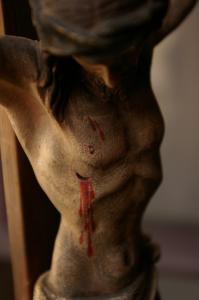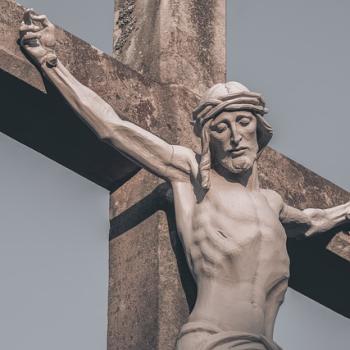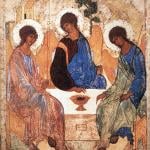Last in a series on Jesus and the Politics of Roman Palestine

Richard A. Horsley is one of the earliest New Testament scholars to make the economic and political conditions of first-century Palestine a key to understanding Jesus. His work and that of few others then represented a courageous break from traditional interpretations. In earlier posts I have explored, and found persuasive, Horsley’s Jesus and the Politics of Roman Palestine as well as similar works by two other scholars. (See here, here, and here for Horsley and here (Ched Myers) and here (William Herzog.)) But I have not found anywhere else the idea Horsley proposes in the final 13 pages of the above book. “Crucifixion as Breakthrough,” Horsley’s last chapter, argues that Jesus’ death by crucifixion, not the resurrection, was the decisive inspiration for the Jesus movement. I will be exploring this last point, on which Horsley has not persuaded me.
Horsley argues well, up to this point, that Jesus was a leader of a peasant/village renewal movement. Jesus’ program included resistance against Roman disruption of traditional village life and against collaboration by Jerusalem’s wealthy elite. Reading Horsley’s last chapter, one gets the impression that, for any practical effect in this world, the resurrection could as well not have happened. It was the crucifixion that was the impetutus for the movement’s expansion. The resurrection gets a mention, offhand, in Horsley’s book, but nothing more.
Jesus, the political activist
Herzog notes the failures of two modern interpretations of Jesus – as an itinerant sage or as an apocalyptic preacher. Roman officials would not have crucified a mere wisdom teacher or prophet of end times. Jerusalem’s elite, with theological concerns, would have meant nothing to Rome. Rome crucified by the thousands actors who threatened their political and economic control. Similarly, Judean officialdom and wealthy families, profiting under Rome’s lead, would have sought to eliminate threats to their position. A purveyor of new theologies or moral platitudes, even a worker of miracles –Palestine could accomodate a few of those well enough.
There is both wisdom teacher and prophet of a new age in Jesus, but he taught and prophesied in service to a political and economic program. It was the same program Jesus’ Scriptures propounded. The same preference for widow, orphan, and stranger. And the same program of debt cancellation, keeping struggling peasant families on their apportioned land. The same, or even stronger, legal prescriptions for preserving and enhancing life in village communities. And – in new circumstances – the same insistence on freedom for God’s people from imperial domination.
In locating Jesus’ work within his political circumstances, Horsley focusses on three “realities not usually considered”: the reason Rome employed crucifixion, how coercive power affected subject peoples, and, notably, the effect a decisive leader can have in stimulating a movement of resistance. (p. 154)
Crucifixion, which Rome employed by the thousands, was not so much punishment of an individual as examples and warnings to any who would oppose Rome. The force of that lesson is not hard to imagine. Neither is it hard to figure out how economic and political oppression would affect a subject population and the angry or helpless feelings it would inspire. Horsley takes special care to specify the role of a leader in articulating such effects and orienting such emotions.
Jesus speaks truth to power
Horsley describes Jesus’ last days before his execution by crucifixion as a time of radicalization of his role as leader of a popular renewal movement. Until then Jesus participated in and encouraged the subtle resistance that subject peoples of many cultures learn to employ when direct opposition is too dangerous. They will say what the empire wants to hear in public but the truth among themselves in private. (p. 163) In public they may code the truth they see in harmless-seeming symbolic language. Many of Jesus’ parables are of this sort.
But Jesus’ last days were marked by more direct confrontation in word and act. Provocative words about the Roman tax and Jewish leaders’ faithlessness. A violent demonstration in the Temple that invited both attention and response. Jesus may well have taken on deliberately the role of the sacrificial leader, “speaking truth to power” and knowing the risk. Such bold speaking and acting, Horsley says, “can transform the collective indignation into an excitement and energy that inspire collective protest or resistance.” And, “a leaders’ public articulation of the people’s indignation is often what energizes the coalescence and expansion of a movement.” (p. 154)
The Crucifixion didn’t leave the disciples in despair, Horsley claims
Horsley first criticizes the traditional idea that the disciples were so dispirited after Jesus’ execution that they had no will to continue his mission. Then he says it wasn’t the resurrection that brought the Jesus movement back to life. Neither of these moves is quite successful.
Horsley considers the disciples’ desertion, their failure to watch with Jesus, and Peter’s denial. All of these may have more to do with a Gospel writer’s literary plan than with reality. They are the “climax of [Mark’s] Gospel’s subplot of the disciples’ failure to understand and follow Jesus.” Thus they don’t allow any conclusion about the disciples’ fear of Rome. (p. 155)
Luke’s story has two disciples on the way to Emmaus in a state of dejection and near despair. But Luke’s purpose is “to strengthen subsequent believers’ recognition of the risen Jesus in the celebration of the Lord’s Supper.” (p. 155) Presumably, the disciples’ feelings just make it a better story rather than reflecting reality.
In John’s Gospel we find the disciples behind locked doors. That’s not because of the crucifixion, Horsley claims, but, as this Gospel says, “for fear of the Judeans.”
Horsley concludes:
It is thus difficult to find any support in the Gospel sources for the previously standard interpretation that crucifixion left the disciples feeling defeated.” (156)
Horsley’s third, and weakest, point is the only one that doesn’t depend on a biblical author’s augmentations of history. But could Mark make up claims about beloved disciples’ failures when eyewitnesses to the people and events were still around? Could Luke ascribe feelings to disciples that some in his audience would know they never felt? Here I’m taking a page from Richard Bauckham’s Jesus and the Eyewitnesses. A Gospel story has to have enough verisimilitude to get past eyewitness censors.
The Resurrection didn’t restart a moribund Jesus movement in Horsley’s view
Horsley next (p. 156) looks for evidence to refute the view that Jesus’ resurrection reanimated the dispirited disciples. I summarize and add some objections:
- The early hypothetical document Q doesn’t mention Jesus’ resurrection.
- But Q consists almost entirely of words of Jesus. Some scholars more traditional than Horsley doubt that Jesus predicted his resurrection. (E.g. `Walter Kasper in Jesus the Christ, p. 115) )
- Mark (16:1-8) ends a promise that Jesus is going ahead of the disciples to Galilee. There they will “presumably continue the movement of renewal that he and they had already started.”
- But one could as easily see here regeneration, rather than continuation, of the Jesus movement.
- In Matthew Jesus gives the commission to “expand the movement [already in progress] by making ‘disciples of all peoples.’”
- But “expand the movement” is Horsley’s phrase. It’s reality for Matthew’s community but not necessarily for the immediately pre- and post-crucifixion disciples.
- In Luke Jesus meets two disciples on the road and “gives instructions for a movement already underway and about to expand (in the book of Acts).”
- Equally, or perhaps even more naturally, one could see the movement at best in pause mode and needing a push from Jesus to restart.
- John is “the only Gospel with clearly bodily resurrection appearances.” The movement (“already well underway”) gets specific instructions from the “farewell discourses.” (John 13-17)
- The farewell discourses, indeed, read like instructions to a movement already underway. But one cannot ignore the hints of trouble for the movement. Jesus predicts Peter’s triple denial, the coming of the Spirit so as to “not leave you orphaned,” and pain turning to joy after a time of not seeing Jesus. What the passage says about the Jesus movement is ambiguous at best.
The Crucifixion and the Jesus movement that followed
What kind of Jesus movement would one expect if Jesus’ crucifixion really were the breakthrough moment? Horsley says such a leader’s daring to risk all would “transform … collective indignation into an excitement and energy that inspire collective protest or resistance.” (163) Such has been the response of other subjugated peoples “when their spokesperson speaks truth instead of more submissive lies and equivocations.” (163) Followers identify with their leader’s challenge. They too “finally talk back and resist rather than submit.” (164)
Horsley indicates that is what one would expect of the early followers of Jesus based on analogy with other colonized and dominated communities scholars have studied. But is talking back and resisting, “public opposition to the imperial order” (p. 167), what we find in New Testament descriptions of Jesus earliest followers? Horsley is able to offer only the vaguest support for such activity.
New Testament communities did find the will to carry on Jesus’ mission in spite of the harsh conditions that Roman domination imposed. Without directly confronting empire, they formed small communities of mutual support. Horsley’s own earlier work, Paul and Empire, describes Paul’s effort to forge connections of support between communities spread across the Roman Empire. His collection of alms for the relatively poor community in Jerusalem would have been Paul’s signature accomplishment. “Would have been” because, Horsley says, it ended in failure.
Conclusion
Jesus and the Politics of Roman Palestine delves deeply into the history of the Roman colony of Palestine. Horsley locates Jesus, his teaching and his actions in that context of oppression, especially of Palestine’s poor. The book is factual and an interesting read. The conclusion is well warranted that Jesus was an agent of resistance to Roman domination and the cooperation of Palestine’s religious and economic elite. He was the leader of a resistance movement among and for Palestine’s lower classes. He strove to reinvigorate peasant and village life in accordance with the God’s law detailed in his Scriptures.
In the last chapter Horsley attempts to find a smooth progression and expansion of the Jesus movement. It starts in Galilean villages, continues through the crucifixion in Jerusalem, and grows into the larger Roman world. All this, Horsley says, without any role for the resurrection or any interruption at Jesus’ crucifixion. The evidence that Horsley gives, including analogies with other colonized peoples, does not seem to be adequate to the task.












